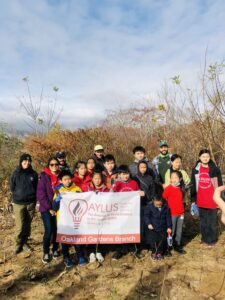On Saturday, November 18th, 2023, from 9 am to 12 pm, volunteers from the Oakland Gardens Branch went to Idlewild Park to participate in a tree planting event.The day was quite sunny and windy, and got warmer as the day went on. This provided a calming and relaxing environment to plant trees.
The trees that we were planting were called the sumac. There are two species of sumac that we planted, which are the staghorn sumac and the smooth sumac. This tree was very hardy and grows perfectly in sandy soil, which is the most common soil type in Idlewood Park. There was also an airport nearby, so we could only plant short trees, such as the sumac. Tall trees could possibly damage the planes.
To keep us working as well as bonding as a group, we made a friendly contest to see who can plant the most trees. Stephanie’s group won with 56 trees planted. After we finished, we estimated that we planted around 300 trees as a group . The New York City Parks Department wanted to plant 3000 trees over the course of a few weeks, and we had helped accomplish 10% of that goal.
We had a few questions, and a park worker answered all of them. One of the questions was, “Why are the trees planted so close?” They told us that it was because the trees grow close in the wild. It is also because as the trees grow, they create shade. If the trees are short, then they can’t create as much shade, but clumping them together creates shade faster. Competing plants need sunlight to grow, so without sunlight, they can’t grow. This makes the trees healthier.
Another question we asked was “What animals live here?” The answer to this question is that there are many different animals and bugs. Some animals are shrews, birds, snails, moles, deer, and voles. Some bugs that inhabited the area were seven-spotted ladybugs, European earthworms, ants, and Aphids. Even though it was cold, we saw most of these creatures. One type of bug that is commonly seen is the black field cricket, or its scientific name, teleogryllus commodus. Empty snail shells were found decomposing in the dirt. Some of us also saw some pokeweed berries and learned that they were highly toxic to humans but a primary food source for other animals.
At the end of the tree planting, the Oakland Gardens Branch went to the Idlewild Environment Center to learn about different animals. We would like to thank the workers for allowing the children to visit the Idlewild Environmental Center. Ms. Gloria, the center staff, was very patient and introduced all kinds of animals, such as frogs, snakes, and turtles to the children! We learned a lot about the animals, what they ate, and their habitat.
We would like to thank all the New York Park Department Workers (Parkies) who helped us!
Calvin
Wes
Sarah
Gabriella
Hannah
Paul
Eric
Galen
John
David
Meredith
Kristy King
Daniel Molinaro
Rebecca
Our Volunteers:
Hong Hao Liu (Alfred): 3 hours
Ioklee Lin: 3 hours
Iokseng Lin: 3 hours
Sophia ShiHan You: 3 hours
Ioknor Lin: 3 hours
Stephanie ShiRan You: 3 hours
Vicki Lin: 3 hours
Jameson Liu: 3 hours
Nina Yang: 3 hours
Grace Lin: 3 hours
Erica Wu: 3 hours
Report written by: Hong Hao Liu (Alfred), Vicki Lin, Sophia Shi Han You










